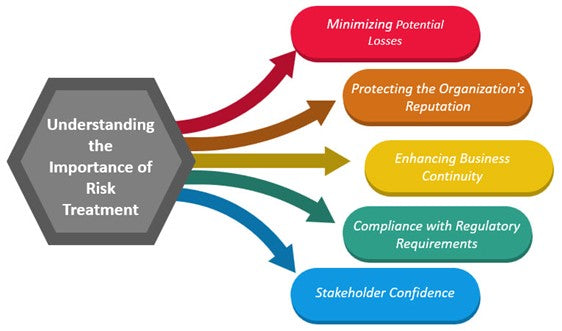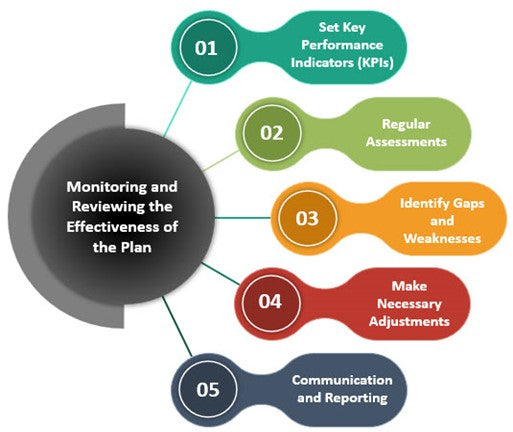Risk Treatment Plan: Understanding The Importance Of Risk Treatment and Its Effectiveness
Risk management is an essential aspect of any successful business strategy. Organizations must develop a comprehensive risk treatment plan to minimize potential risks and mitigate their impact effectively. This plan outlines the various strategies and tactics that will be implemented to address and manage identified risks.
Organizations can protect their assets, reputation, and overall business operations by proactively addressing risks and developing appropriate risk management strategies. This article will explore the importance of a risk treatment plan and discuss critical elements that should be included in its development.

Understanding the Importance of Risk Treatment
Organizations must understand the importance of implementing a risk treatment plan to manage risks effectively. This section will explore why a risk treatment plan is essential in safeguarding the organization's assets, reputation, and overall business operations.
1. Minimizing Potential Losses: One of the primary objectives of a risk treatment plan is to minimize potential losses that may arise from identified risks. Organizations can effectively reduce the likelihood and impact of adverse events by implementing appropriate risk management strategies. This proactive approach protects businesses' financial resources, investments, and profitability.
2. Protecting the Organization's Reputation: A solid risk treatment plan helps safeguard the organization's reputation. With a proactive risk management approach, organizations can identify and address potential risks before they escalate into significant issues, thereby preserving their reputation and trustworthiness in the eyes of stakeholders.
3. Enhancing Business Continuity: Disruptions in business operations can have severe consequences for organizations. A risk treatment plan ensures that appropriate measures are in place to mitigate the impact of natural disasters, supply chain disruptions, or cyber-attacks. By identifying these risks and developing contingency plans, organizations can ensure uninterrupted operations and minimize the potential for disruptions.
4. Compliance with Regulatory Requirements: Many industries are subject to various regulatory requirements. A comprehensive risk treatment plan considers the legal and regulatory landscape in which the organization operates. The organisation can avoid legal penalties, reputational damage, and potential business disruptions by addressing compliance-related risks and implementing strategies to adhere to applicable laws and regulations.
5. Stakeholder Confidence: A robust risk treatment plan demonstrates the organization's commitment to ensuring the well-being of its stakeholders, including customers, employees, shareholders, and business partners. By actively managing risks and implementing appropriate measures, organizations instil confidence in their stakeholders, fostering stronger relationships and long-term business success.
Identifying and Assessing Risks
Before implementing a risk treatment plan, it is crucial for organizations to identify and assess potential risks that could affect their operations. This step is essential in developing an effective risk management strategy and prioritizing resources and efforts.
Here are the critical elements involved in the process of identifying and assessing risks:
1. Risk Identification: The first step in the risk management process is to identify all potential risks that could impact the organization. This involves comprehensively analysing the internal and external factors that could pose a threat. Internal risks may include operational inefficiencies, human error, or inadequate cybersecurity measures, while external risks can range from economic downturns and natural disasters to regulatory changes and market volatility. To ensure a comprehensive perspective, it is essential to involve key stakeholders from different departments or business units in this identification process.
2. Risk Assessment: Once the risks have been identified, organizations need to assess the likelihood and impact of each risk. This involves evaluating the probability of the risk occurring and its potential consequences on the organization's objectives. The assessment should consider factors such as the severity of the impact, the frequency of the risk occurrence, and the organization's tolerance for risk. Qualitative and quantitative methods can evaluate risks, including risk matrices, scenario analysis, and historical data analysis. Organizations can prioritize their focus and resources on the most significant risks by assigning a risk rating or score to each identified risk.
3. Risk Documentation: It is essential to document the identified risks and their assessment findings in a structured and centralized manner. This documentation provides a reference for all stakeholders involved in the risk management process and facilitates effective communication and decision-making. The risk register or risk inventory should include information such as the description of the risk, its potential consequences, the likelihood and severity of the risk, and any existing control measures or mitigation strategies in place.
4. Risk Mitigation and Control: Organizations can develop and implement appropriate risk mitigation and control measures once the risks have been identified and assessed. These measures are designed to eliminate or minimize the likelihood and impact of the identified risks. The effectiveness of these measures should be regularly reviewed and monitored to ensure their ongoing suitability and effectiveness.
5. Risk Monitoring: Risk management is an ongoing process, and organizations must continuously monitor and review their risk landscape. This can be done through regular risk assessments, internal audits, external reviews, and monitoring of key risk indicators.
By effectively identifying and assessing risks, organizations can develop a comprehensive understanding of the potential threats they face. Identifying and assessing risks lays the foundation for proactive risk management and ensure organizations are well-prepared to navigate the ever-changing business landscape.
Implementing Risk Treatment Measures
After identifying and assessing the risks, the next crucial step in the risk management process is to implement appropriate risk treatment measures. These measures are designed to mitigate or control the identified risks and minimize their potential impact on the organization.
Here are the key considerations and steps involved in implementing risk treatment measures:
1. Risk Prioritization: Once the risks have been assessed, it is important to prioritize them based on their significance and potential impact. Not all risks may require immediate attention or the same level of response. By prioritizing the risks, organizations can allocate.
their resources effectively and focus on addressing the most critical risks first.
2. Risk Treatment Options: Different risk treatment options are available depending on the nature and severity of the risks. Some standard risk treatment options include:
a. Risk Avoidance
b. Risk Transfer
c. Risk Reduction
d. Risk Retention
3. Developing Risk Treatment Plans: Organizations need to develop detailed risk treatment plans once the risk treatment options have been identified. These plans outline the specific actions and strategies to address each identified risk.
4. Allocating Resources: Implementing risk treatment measures requires allocating appropriate financial, human, and technological resources. Organizations need to ensure that sufficient resources are allocated to support the implementation of risk treatment plans.
5. Communication and Training: Effective communication and training are essential for successfully implementing risk treatment measures. All relevant stakeholders, including employees, management, and external partners, should be informed about the risks, the selected treatment options, and their roles and responsibilities in implementing the plans.
6. Monitoring and Review: Risk treatment measures should be continuously monitored and reviewed to ensure effectiveness. Regular assessments should be conducted to evaluate the progress of the implementation, identify any gaps or weaknesses, and make necessary adjustments.
Organizations can address the identified risks and reduce their potential impact by implementing effective risk treatment measures. Regular monitoring and review of the risk treatment measures enable organizations to stay proactive and adapt to changes in the risk landscape, ensuring ongoing protection against potential threats.

Monitoring and Reviewing the Effectiveness of the Plan
Organizations must continuously monitor and review their effectiveness once the risk treatment measures have been implemented. Monitoring and review help ensure the implemented measures achieve the desired outcomes and effectively mitigate the identified risks.
Here are the key considerations and steps involved in monitoring and reviewing the effectiveness of the risk treatment plan:
1. Set Key Performance Indicators (KPIs): Organizations should define specific KPIs to assess the performance and effectiveness of the risk treatment measures. For example, if the objective is to reduce the likelihood of data breaches, a relevant KPI could be the number of successful cyberattacks on the organization's systems.
2. Regular Assessments: Regular assessments should be conducted to evaluate the implementation progress and measure the impact of the risk treatment measures. These assessments should be conducted at defined intervals, such as quarterly or annually, depending on the nature of the risks and the organization's risk appetite.
3. Identify Gaps and Weaknesses: During the assessments, it is essential to identify any gaps or weaknesses in the implemented risk treatment measures. Identifying gaps and weaknesses helps organizations understand areas where the implemented measures may fall short and enables them to take corrective actions.
4. Make Necessary Adjustments: Organizations should adjust the risk treatment measures based on the assessment findings. The adjustments should address the identified gaps and weaknesses and improve the overall effectiveness of the risk treatment plan.
5. Communication and Reporting: Communication is critical in monitoring and reviewing the effectiveness of the risk treatment plan. This helps maintain transparency and ensures all stakeholders know the organization's risk management efforts.
By monitoring and reviewing the effectiveness of the risk treatment plan, organizations can ensure that they are proactively managing the identified risks. This ongoing monitoring and review process is essential for maintaining robust risk management practices and safeguarding the organization's assets, reputation, and overall business operations.
Conclusion
The monitoring and reviewing phase of the risk treatment plan is crucial for organizations to ensure the effectiveness of the implemented measures. By setting specific KPIs, conducting regular assessments, and identifying gaps and weaknesses, organizations can make necessary adjustments to improve the plan's overall effectiveness.
Regular communication and reporting with stakeholders help maintain transparency and keep everyone informed about the progress and results of the risk treatment plan. Seeking external reviews or feedback can provide valuable insights and recommendations for further improvement.



